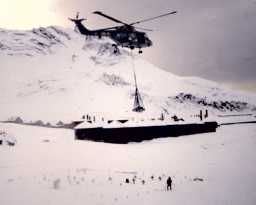SOUTH GEORGIA CEMETERY PROJECT 1998/99
Initial Deployment of equipment to the whaling stations
25th September 1998
We arrived back in South Georgia in early July. Pat's job as Marine officer at King Edward Point (KEP) has given us both time to gather all the food, fuel, materials and tools together in plenty of time before we deploy to Husvik in November.
Earlier in the year Sarah identified and sorted a huge pile of scrap chain from Grytviken whaling station, enough to be able to put complete fences aroud two cemeteries at Leith and one at Stromness.
HMS Edinburgh came from the Falklands a couple of weeks ago to carry out the regular resupply of the small British Garrison stationed at King Edward Point and very kindly agreed to use their helicopter to help us get our supplies around to Husvik, Stromness, and Leith. By this time the chain was gathered up and tied onto pallets ready to go to each of the stations and all our other supplies were either in boxes or on pallets. The alloted day for the cargo move started with a fresh blanket of snow and more snow falling heavily. There was no chance of getting the helicopter launched but we did get the boxes out to the ship using a boat driven by the members of the garrison at KEP when the snow stopped for an hour or two.
Fortunately the next day was clear and sunny and we set off. We both went out to the ship by boat and the ship sailed from KEP for Stromness Bay. After a safety briefing, Pat togged up in plenty of warm clothing , a waterproof immersion suit and life jacket and boarded the helicopter for the first flight to Lieth. Steve 'Bolts' Bolton, the pilot, tried to set down on the old football pitch, a rare flat area on the island which is conveniently near the first drop zone - the out-of-town cemetery at Leith.
As we approached the ground, the fresh powder snow that had fallen the previous day was lifted by the downdraught from the rotor blades and suddenly we were in a complete whiteout. The snow was recirculating - being blown high enough in the air to be sucked in from above and blown back down. Bolts snapped his eyes from where the horizon had been to his instruments and with a lurch we were up above the danger. Time for plan B.
The crewman , 'Paddy' McWilliams, opened the rear door, put a strop around my chest, and manoevred me to a sitting position, dangling my legs over the edge of the floor into the void below. Bolts held the aircraft in position as I was winched down thirty or forty feet to a very soft landing in thigh deep snow. A gound crewman was then winched out after me and the helicopter disappeared to fetch the first load., leaving us to enjoy the absolute silence of a calm summy day in South Georgia. Once the first load, a pallet of chain weighing quarter of a ton, had been delivered right next to the cemetery, the two of us walked, or rather floundered, through the snow drifts to the centre of the station where the next load was to be delivered. A ten minute stroll in summer took about three quarters of an hour wading through the snow that had drifted up around the station buildings.

We had just about found a building that was intact enough to store the goods for two months when the helicopter clattered back into view and deposited another load of chain. The next two loads were boxes of tools, jerries of fuel, food and supplies etc which all had to be manhandled through the snow for a couple of hundred metres from an area flat and open enough for the helicopter to operate to the old galley building. We had to improvise a sledge from a piece of corrugated iron to be able to move the heavier boxes and by the time they returned to pick us up were stripped down to t-shirts and still sweating profusely.
The pickup was another demonstration of the pilot's skill. He lowered himself onto a jetty where there was not enough snow to cause a whiteout . Without actually landing - the jetty was not quite wide enough for all the wheels to touch - he hovered low enough for the two of us to climb back into the cab.
Meanwhile, Sarah had been landed at Stromness with a handful of boxes and jerry cans of fuel by boat while the crewmembers from the ship were ashore for a 'legstretchers' or walk about. She was able to take skis and with another improvised sledge put the stores into the safe house where we will stay whilst working on the Stromness cemetery.
Another group from the ship were landed at Husvik at the same time that we were in Leith and Stromness and ferried another large quantity of stores into the manager's villa there.
We must take this opportunity to express our deepest thanks to everyone on HMS Edinburgh for all their help, without which the logistics of moving all of our stores around this island would be much more arduous.